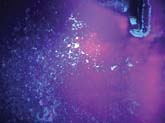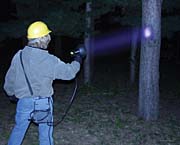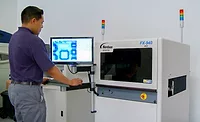New Optically Active Coating System Revolutionizes Quality Control and Structural Inspection
NCP Coatings Inc., innovators in commercial and industrial coating products since 1948, has introduced its new optically active coating system (OACS). The OACS system is designed for a variety of manufacturing and inspection applications, including the following.
- Critical applications where coating, substrate or product integrity cannot be compromised by uneven or flawed coatings.
- Coating applications that must have lifetime inspections for detection of structural integrity, corrosion, or potential holding tank or pipeline leakage.
- Quality assurance inspections of specified coatings that are crucial to manufacturing integrity, or wherever there is a possibility of counterfeit OEM components being passed as quality parts and components.
The OACS pigment system can be formulated to coat conventional or composite materials to ensure structural integrity or thickness inspections only under ultraviolet light. "The beauty of the OACS coating system is that it's invisible in the ambient light," he said. "When used as a primary coating, or as an undercoating, OACS coatings are only visible under ultraviolet light. Consequently, the practical quality control and myriad of structural inspection applications are only limited by one's imagination."

Industrial, Architectural and Manufacturing Applications
The OACS system is designed for an incredible variety of application areas and industries: marine, shipbuilding, architectural, automotive, building/construction, industrial maintenance, metal working, foundries, tool and dye, refineries and petroleum storage, waste treatment management, aviation, aerospace, nuclear power generation, logging, security verification systems, or any other industrial or commercial application. The system is suited for jobs demanding high-quality coating, inspections for structural integrity, or those that require regular inspections of production runs to prevent counterfeiting of components. OACS is a solution to engineers facing the challenges of installations that have routine maintenance, inspection and documentation. In these cases, coatings incorporating OACS help prevent the risk of costly refurbishment, reconstruction, or parts recalls.NCP Coatings COO Ben Hannewyk (Admin.) explained a typical application. "A good example of where [OACS] improves the quality of the coating process is in our marine experience with U.S. Navy vessels and large marine tanker ballast tanks. A common problem with paint films is that they crack with aging for a number of reasons - shrinkage, substrate stress, physical damage and thermal stress, just to name a few. This cracking is a major source of corrosion damage in structures. By adding our OACS materials to an existing paint formulation, it makes the coating reactive to inspection by specialized ultraviolet light. The coating is then applied to the surface. A second coating without the OACS additive is applied as normal.
"Under the ultraviolet light inspection, any paint cracking, crazing, imperfections or total failures appear as brighter areas. This shows the protective coating has failed and the OACS undercoating is exposed to the UV light from underneath. When the cracks expose the substrate, the OACS will form a halo around a black area. These situations can be easily detected with the UV light source."
Thus, sweeps of large, or hard-to-reach areas can be inspected quickly and efficiently as compared to the time-consuming, labor-intensive electronic, spot-checking conventionally used. In non-electric conducting materials, such as cement, fiberglass or plastic tanks, OACS is a perfect match for defect detection. "In addition, throughout the life of the vessel or tank, coating degradation can easily and quickly be monitored and captured digitally to record the systems performance and resistance to wear and corrosion," Hannewyk said.

Industrial Applications
Nat Hannewyk, COO (Fixed Operations) for NCP Coatings, elaborated on the critical applications of OACS. "We see a number of industrial applications that would benefit companies using our OACS system. These include wastewater treatment, power plants, nuclear reactor facilities, petroleum storage or pipelines, chemical storage and distribution systems - any application where corrosion or structural integrity is a concern is a viable application for OACS. We believe that the OACS system will help our customers find problem areas for maintenance and repair before costly government fines or equipment failure occurs."He went on to explain that this kind of unprecedented in-process visual monitoring of coating systems can save time and cut costs and labor in precision coating situations such as aeronautics, government MIL specifications, medical equipment applications, critical machine parts or exacting automotive jobs.
"In addition to scrutinizing structural integrity," Hannewyk said, "OACS can be used to monitor the quality and coverage of critical applications of the wet film as it is being applied. By adding the OACS to the first coat then subsequently coating with a passive or non-OACS coat, the person applying the coat can check for coverage for each coat without having to wait until the coat dries. In some cases that saves you 8-16 hours, plus the labor and equipment expense. With a simple sweep of a specialized ultraviolet light, missed areas or thin application areas can be quickly identified and actually remedied during painting process. The time, materials, and efficiency savings here are potentially huge."
Hannewyk explained that after the primer or first coat containing NCP OACS pigment is applied, the part glows brightly under the special UV light. At this time, the part is inspected under the UV light for complete and uniform coverage of the primer coat. Now after the first coat dries, a second coat without OACS is added to the part. "Once this part is totally painted, one would see a completely dark image under the UV light to show you now have a complete uniform coverage. There's no guesswork here. If the part is still glowing under the UV light, the paint is either too thin in areas or a spot has been missed. Both the primer coat and the top coat can be the same color to the naked eye."
In addition to ensuring complete coating coverage, this same procedure can be used to prevent over application. Moreover, an image of the inspected area can be recorded digitally for reporting purposes and future reference.
"The same method of adding OACS to every other coating can be used to monitor coating removal. This results in significant time savings in surface preparation techniques. With the OACS system we are seeing shorter inspection times, quicker turns in the paint cell, reduced re-work, better first-time quality of application, improved DFT control and proof of edge coverage, and better visual and recorded documentation."
With the visual imaging inspection capabilities this new product offers, using OACS can also ultimately lead to a savings in reduced paint volumes through less over spraying and repainting in the paint booth. "It's hard to imagine any critical industry which uses paints and coatings not integrating the OACS system in their manufacturing mix - if only for the quality control applications and the reduced rework costs alone," Hannewyk said.

Quality Control and Combatability with Primary Paint Formulations
NCP Coatings Optically Active Coating System can be used on virtually any material - conducting, non-conducting, metal, or non-metal."One big advantage of the OACS is its material application versatility," said Randy Terrill. "Because the system is optical, the nature of the substrate does not interfere with the effect. The substrate does not need to be conductive or magnetic for application or inspection. OACS can be used on concrete, fiberglass, GRP, and many other materials. That material can either be coated or impregnated with OACS depending on the best return on investment."
Terrill added that OACS is safe - it can be applied to childrens' toys, it's available in different colors, and it's easy to formulate in high solids epoxy coatings. And since OACS is used in low volumes, there's less chance of interference or migration with an existing product. "OACS is simple to integrate into most industries. The surface preparation is done in accordance within the paint manufacturers' recommendations for the coating being applied. No special requirements are necessary for using OACS. Thus for most applications and industries, there is no need to change standard operating procedures, no need for new equipment, and no need for additional training." Optically Active Coating Systems provide boundless opportunities for quality control, defect detection, and protection of product brand names.

Quality Assurance and Counterfeiting Detection Systems
According to M. Sherman Drew Jr., executive vice president and director of NCP's Optically Active Coating Systems provide engineers - civil, construction, chemical, electrical, mechanical, marine, and packaging - boundless opportunities for quality control, defect detection, and even protection of product brand names."I can't emphasize it enough that the only limit to OACS is an engineer's imagination," Drew said. "Here's a common situation with automotive and heavy machinery. Let's say your firm is concerned with the counterfeiting of its components by unscrupulous organizations. Working with your coating department and end users, OACS can be used to identify original OEM parts. Since OACS is invisible in ambient light, but shows up only under specialized ultraviolet light, special patterns or color codes can be applied to your firm's components. OACS employed in this manner can be fairly sophisticated against copycats because the coating can be tuned to a specific frequency of ultraviolet light."
Drew continued, "We are also seeing similar applications for marking trees for logging in forestry. In short, OACS is a viable and valuable tool where product authenticity must be easily identified from possible counterfeit look-alikes."
Safety and Security
Another key area where OACS can solve inspection problems is inspecting the structural integrity of large structures. An OACS coating can be applied to the steel structure supports, foundations and concrete walls. An inspector using a specialized ultraviolet light can quickly inspect the bridge for flaws and cracks. "Just think what this speed and efficiency as well as the visible image documentation can mean to someone in charge of a large building, highway or railway bridges, water towers, waste water treatment tanks, chemical or fuel tanks. Our new OACS coatings will be invaluable for inspection of structures in earthquake zones, marine vessels, or airplanes." Drew said.Currently, NCP Coatings is working for the certification of its Optically Activated Coating Systems for a number of key customers, including the U.S. Navy. "Thus far the customers considering the integration of the OACS coatings are estimating savings in the range of millions of dollars," Drew said. "In short, the quality of application, the in-process and post process detection, and the benefits in paint volume and time savings make OACS something worth investigating for today's critical parts and structures which require regular inspections and performance documentation."
For more information, contact NCP Coatings, 225 Fort St., Niles, MI 49120-307; phone 800/627.1948; fax 269/683.3305; or visit www.ncpcoatings.com.
Looking for a reprint of this article?
From high-res PDFs to custom plaques, order your copy today!







